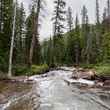Low sun angle provides a significant advantage to the angler. The shadows are deeper; they’re wider and longer. In the winter months, the sun sits lower in the sky, and that shallow arc creates more shadows with less direct sunlight. Trout love the dark areas and seek them out.
By contrast, the summer solstice has the sun directly overhead. The hard sunlight beats straight down, erasing the comforting shadows and putting trout on edge.
In all seasons, watching the angles of sunlight and looking for shadows is an important part of the fisherman’s strategy while on the water.
Unfortunately, most of us can’t choose the hours or the skies that we fish under. We fish when we can, and we try to make time even when we can’t. Most of us don’t look at the weather report to decide when to fish. We look at the calendar and the schedule book. We look at the to-do list. Then we say “screw it” and go fishing. Often, our boots are already in the water before we truly observe the conditions we’re under.
Whether you can or cannot pick the types of light you get to fish under, there are several ways to deal with the conditions that greet you (even difficult ones) and make the best of the situation.
Fish low light
Fishing periods of low light is part of the basic blueprint for most anglers: fish the early mornings, fish last light, and fish the dreary, drizzly days. We know this. We recognize that clouds in any form are a welcome friend. Solid white skies are good, and grey skies are even better. My raincoat has a purpose, and I use it every chance I get.
Fishing action often picks up when the rain starts, and that has just as much to do with low light as it does with dislodged nymphs and displaced baitfish. Trout relish the chance to feed under cover, and while the incoming rain usually carries some silt and debris, giving color to the flow, grey skies also drop the light level and signal a feeding time.
Any low-light period is a great time to be on the water. There are no guarantees in our sport, but you can stack some of the odds in your favor by fishing under low-light.
Keep the sun at their backs
I look up to see sunny skies too often for my liking. And the presence of any sun dings my confidence level a bit. But then I start looking around, because I have some solutions.
High sun from straight upstream is the worst. Since most trout face into the current, the bright light is directly in their eyes. Have you ever driven east on a clear highway in the early morning? It’s not very comfortable — same thing for the trout.
Brown trout are especially averse to hard sun. They are negatively phototropic, which is a ten-dollar phrase for “don't like bright lights.” Sure, trout will feed under direct light, but it usually takes a hatch or another significant event to break them out of their wary instincts and face the sunlight.
I do all that I can to keep direct sunlight behind or to the side of trout. I know what direction my local rivers flow, and I purposely choose to fish ones that flows east on early, clear mornings (keeping the sun behind the fish). I know where the big bends in the river are, and I happily walk two hundred yards to change the angle at which the sunlight reaches the trout. It’s worth it. It makes a difference, and I’ve seen the results too many times to believe otherwise.
I first recognized this many years ago on a favorite river with a 180 degree bend and a tunnel. Fishing was excellent all morning, and around noon I ventured through that tunnel to fish the other side. Conditions were identical: water type, speed, bug activity. And the river was void of anglers. The only change was the position of the sun. On the other side of the tunnel, the sun’s rays came from directly upstream. I caught a few fish over the next two hours, but the difference was striking. Eventually, I gave up and walked back through the tunnel to fish with the sun behind the trout, and once again the fish came to the net easily.
Since that day, I’m more aware of the sun’s angle. I also greedily search for more shade in all conditions.
Find the Shadows
There are always shadows. Even with high sun upstream and overhead, they can be found. On big rivers we might not have the luxury of changing the angle of the sun by walking around the bend. Then it’s time to look for undercut banks and overhanging trees. Some rivers are void of all these features. But in the worst light conditions there are still small shade lines around the edges of rocks and submerged tree parts.
In high sun, I pass up a lot of water to find the next bit of shade.
Also, I generally stay away from fishing streamers under bright lights. I’d rather fish dries or nymphs. Trout are less willing to expose themselves and take a risk in these conditions. They seem to want their food coming directly to them — they want an easy meal that drifts into their shade line. Sunny conditions, then, usually require more accurate casts and precise drifts.
Finding the shady cracks that harbor resting and wary trout is a good challenge on bright days. Offering the flies to them in those small and dark spots is another.
Wherever and whenever you find low light — use it.

































Comments